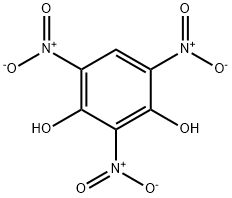CHEMICAL AND PHYSICAL PROPERTIES
| Physical Description | Trinitroresorcinol appears as a yellowish, crystalline solid. Used as a priming agent. Very sensitive to heat. Primary hazard is blast of an instantaneous explosion, not flying projectiles or fragments. Under prolonged exposure to fire or heat the containers may explode violently. |
|---|---|
| Ionization Efficiency | Negative |
| Chemical Classes | Other Uses -> Explosives |
COMPUTED DESCRIPTORS
| Molecular Weight | 245.10 g/mol |
|---|---|
| XLogP3 | 1.1 |
| Hydrogen Bond Donor Count | 2 |
| Hydrogen Bond Acceptor Count | 8 |
| Rotatable Bond Count | 0 |
| Exact Mass | 244.99201406 g/mol |
| Monoisotopic Mass | 244.99201406 g/mol |
| Topological Polar Surface Area | 178 Ų |
| Heavy Atom Count | 17 |
| Formal Charge | 0 |
| Complexity | 317 |
| Isotope Atom Count | 0 |
| Defined Atom Stereocenter Count | 0 |
| Undefined Atom Stereocenter Count | 0 |
| Defined Bond Stereocenter Count | 0 |
| Undefined Bond Stereocenter Count | 0 |
| Covalently-Bonded Unit Count | 1 |
| Compound Is Canonicalized | Yes |
PRODUCT INTRODUCTION
description
Trinitroresorcinol appears as a yellowish, crystalline solid. Used as a priming agent. Very sensitive to heat. Primary hazard is blast of an instantaneous explosion, not flying projectiles or fragments. Under prolonged exposure to fire or heat the containers may explode violently.

